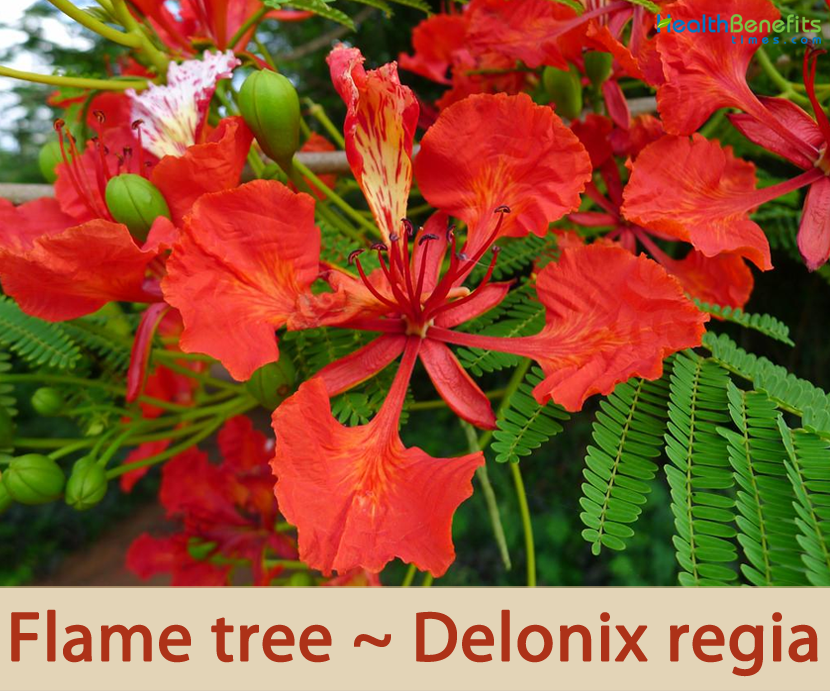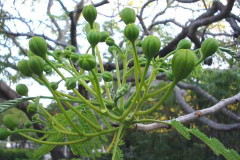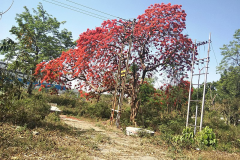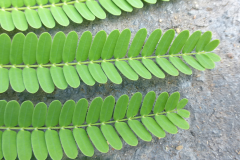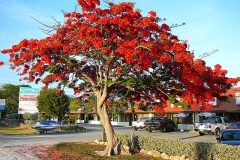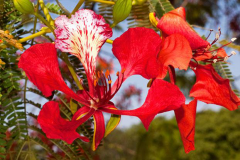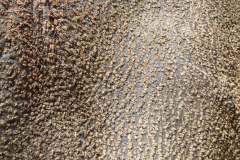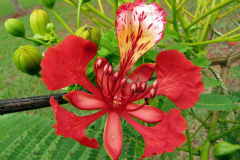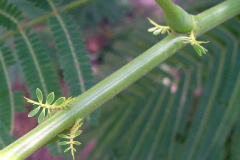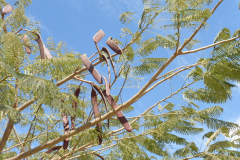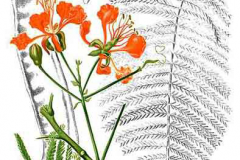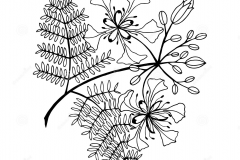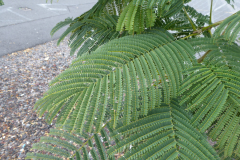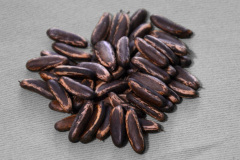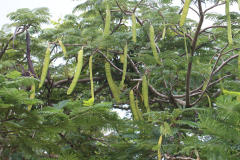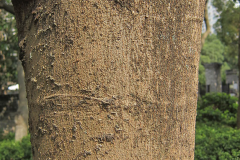| Flame tree Quick Facts | |
|---|---|
| Name: | Flame tree |
| Scientific Name: | Delonix regia |
| Origin | Northern and western Madagascar and Zambia |
| Colors | Pale green to reddish-brown when young turning to dark brown or black as it matures |
| Shapes | Hard, woody dehiscent legume, linear-oblong, flat, straight or curved, pendent pod, 30–60 cm long, 3–5 cm wide, containing numerous seeds |
| Health benefits | Support menstrual cramps, constipation, inflammation, rheumatoid arthritis, diabetes, pneumonia, malaria, hemiplegia, mouth ulcers, earaches and cures baldness and hair fall |
| Name | Flame tree |
|---|---|
| Scientific Name | Delonix regia |
| Native | Northern and western Madagascar and Zambia. It is exotic in Brazil, Burkina Faso, Cyprus, Ethiopia, India, Jamaica, Nigeria, Puerto Rico, Singapore, South Africa, Uganda, United States of America, Egypt, Eritrea, Kenya, Mexico, Niger, Sri Lanka, Sudan, Tanzania |
| Common Names | False Acacia, Flambouyant, Flamboyant, Flametree, Flame-Of-The-Forest, Gold Mohur, Gul Mohr, Julu Tree, Malinche, Peacock-Flower, Poinciana, Red Tree, Royal Poinciana, flame tree, gold mohar, peacock flower, royal peacock |
| Name in Other Languages | Amharic: Dire dawa zaf. Arabic: Zahr El Gannah, Goldmore, bunisyana (بونسيانا) Assamese: Kr̥ṣṇacūṛā (কৃষ্ণচূড়া) Bengali: Krishnachura (কৃষ্ণচূড়া), Chura, Radha chura, Brazil : Flamboiã, uaruna Bulgarian: Ogneno dŭrvo (огнено дърво) Burmese: Seinban, hceinpaann pain (စိန်ပန်းပင်) Carolinian: Fáyárbaw, Nfayarbaw Catalan: Delònix Chamorro: Arbol Del Fuego, Arbol Del Fuego, Atbot, Atbot, Atbut Chinese: Guo Luo Mai Liang, feng huang mu (鳳凰木), Hong hua ying Chuukese: Meei Flower Colombia: Clavellino Cook Islands: Marumaru, Pātai, Pū Pī, Puka Kai, Rākau Tāmarumaru Costa Rica: Malinche Creole: Poinciana royal Cuba: Flamboyán, framboyán, framboyán rojo Danish: Flamboyant Træ Dutch: Flamboyant English: Flamboyant Tree, Flame Of The Forest, Flame Tree, Royal Poinciana, Flamboyant, Flame-of-the-forest, Flametree, Peacock-flower, Flamboyan, Gold Mohar, July Tree, Flamboyant Poinciana, fire tree, royal Poinciana Estonian: Kuning-Leekpuu Ethiopia: Dire Dawa Zaf Fijian: Sekoula Finnish: Heloliekkipuu, Liekkipuu French: Flamboyante, Flamboyant, Pacayer, Poinciana, Flamboyan, Mille Fleurs, fleur de paradis French Polynesia: Pakai, puke, ra‘ar marumaru Fulah: Chelen-ghi German: Fammenßaum, Feuerbaum, Pfauenbaum, Flammenbaum Greek: Dilónix i vasilikí (Δηλόνιξ η βασιλική) Guatemala: Llama Del Bosque Haitian: Pye Flanbwayan Hawaiian: Ohai Ula, Gulmohar Hebrew: צאלון נאה Hindi: Gulmohar (गुलमोहर), Gulmohr, Kattikayi, Peddaturyl, Shima Sunkesula, alasippu, doddartnagrandhi, erraturyl, gulimohur, gulmohur, gultora, kattikayi, mayarum, mayirkonri, panjadi, peddaturyl, shima sunkesula Honduras : Guacamaya Hungarian : Tűzvirágfa I-Kiribati : Te Kai Te Tua, Te Tau, Te Tua Indonesia : Merak, Flamboyan Japanese: Howoboku (ホウオウボク) Kannada: Kempu Torai , Kempu turai (ಕೆಂಪುತುರಾಯಿ), Kattikaayi mara (ಕತ್ತಿಕಾಯಿಮರ), Seeme sankeshwara (ಸೀಮೆಸಂಕೇಶ್ವರ), Gulmahar (ಗುಲ್ಮಹರ್) Korean: Bonghwangmog (봉황목) Madagascar: Alamboronala, Hintsakinsa, Hitsakitsana, Kitasakitsabe, Sarongadra, Tanahou, Tsiombivositra Malagasy: Alamboronala, Fannou, Harongadra, Hintsakinsan, Hitsakitsana, Kitsakitsabe, Monogo, Sarongadra, Tanahou, Tsiombivositra, Volobara Malay: Pokok Semarak Api Malayalam: Gulmēāhar (ഗുൽമോഹർ) Maori (Cook Islands): Marumaru, pātai, pū pī, puka kai, rākau tāmarumaru Malagasy: Alamboronala, Hintsakinsa, Kitsakitsabe, Sarongadra, Tanahou, Tsiombivositra Malaysia: Semarkat Api Marathi: Gulmōhar (गुलमोहर) Mauritania: Voulatzana Mexico: Malinche, tabachín Micronesia, Federated states of: Fáyárbaw, meei flower, sakuranirow, nfayarbaw, pilampwoia weitahta, Mizo: April-par Nauruan: Bin Nepali: Gulmōhar (गुलमोहर) Niuean: Pinē North Frisian: Flamenbuum Norwegian: Flamboyant Oriya: କୃଷ୍ଣଚୂଡ଼ା Papiamento: Flamboyan Pakistan: Gul Mohar Palauan: Nangiosákura, Nangyo Persian: دلونیکس رگیا Philippines: Cabellero Pohnpeian: Pilampwoia Weitahta Polish: Wianowłostka, Wianowłostka Królewska Portuguese: Flamboyant, Flamboiã Punjabi: Gulamōhara (ਗੁਲਮੋਹਰ) Russian: Pfauenbaum, ognennoye derevo (огненное дерево), Deloniks korolevskiy (Делоникс королевский) Samoan: Elefane, Tamaligi Santali: ᱠᱨᱤᱥᱱᱚᱪᱩᱲᱟ Sinhalese: Mal-mara Spanish: Árbol De Fuego, Atbot Det Fuegu, Flamboyant, Acacia Roja, Clavellino, Flamboyán, Flor De Pavo, Framboyán, Guacamaya, Josefina, Morazán, Poinciana, Tabachine, flamboyant colorado, flor de fuego, guacamayo, malinche, morazan, tabuchín, pajarilla, árbol de la llama, árbol del matrimonio Sri Lanka: Mal-Mara, mayirkonri, panjadi Swahili: Mjohoro, Mkakaya Swedish: Flamboyant Tagalog: Puno ng apoy Tahitian: Pakai, Puke, Ra‘Ar Marumaru Tamil: Mayarum, Mayirkonrai, Panjadi, Poo-Vahai , Mayaram, Cem’mayiṟkoṉṟai (செம்மயிற்கொன்றை) Telugu: Turāyi (తురాయి) Thailand: Hang Nok Yung Farang (หางนกยูงฝรั่ง) Tongan: Ohai, ‘Ōhai Lahi Tongarevan: Pātai Tuamotuan: Faefae Turkish: Ateş Ağacı, Cennet A Tuvaluan: Fuatausaga, fuaitansanga Ukrainian: Vohnyane derevo (Вогняне дерево) Ulithian: Warapig Urdu: Gulmohar USA/Hawaii: Ohai ‘ula Venezuela: Acacia roja Vietnamese : Phượng, Phượng Vĩ Wallisian: Ohai West Africa : Sekeseke ( Yoruba ) Yapese: Sakuranirow Yoruba: Sekeseke |
| Plant Growth Habit | Conspicuous, spreading, medium sized, fast growing, deciduous, broad-crowned, evergreen, ornamental legume tree |
| Growing Climates | Adorning avenues, parks and estates in cities in the Caribbean and throughout the tropical/subtropical regions worldwide. It occurs in dry to mesic, disturbed sites, in margin of forest and roadsides, in homesteads, in parks and in gardens, rainforests, coastal monsoon vine thickets and waste areas |
| Soil | Tolerate drought, poor soils and salty conditions. It grows well in moist, well-drained soil derived from limestone and sandy soils but will also grow on clayey soils |
| Plant Size | Usually grows less than 10 m tall, but occasionally reaches up to 15 m in height. The bole is sometimes relatively short. The trunk may reach 2 m in girth and it can be buttressed towards the base |
| Root | Shallow-rooted |
| Crown | Crown is umbrella-shaped, broadly spreading its long horizontal branches. |
| Bark | Grey and smooth bark, sometimes slightly cracked, with lenticels |
| Twigs | Twigs are stout, greenish, finely hairy when young becoming brown. |
| Leaf | Leaves are bipinnate, alternate, feathery, 20-60 cm long, bearing 10-25 pairs of pinnae, each with 30-60 opposite leaflets. The leaflets are 0.5-1 cm long, stalkless, minutely hairy on both sides |
| Flowering season | Australia: November–February Bangladesh: April–May Bermuda: May–August Brazil: October–February Canary Islands: May–September Caribbean: May–September Congo DR: November–December Dominican Republic: July–September Egypt: May–June South Florida: May–June Hawaii: May–June Hong Kong: May–June Indian subcontinent: April–July Israel: May–June Lebanon: June–August Malawi, Zambia and Zimbabwe: October–December Malaysia : November–December Northern Mariana Islands: March–June Mauritius: November–December Pakistan: April–May Philippines: April–June Peru (coast): January–March Reunion Island: November–January Southern Sudan: March–May South Texas: May–June Thailand: April–May United Arab Emirates: May–July Vietnam: May–July Zanzibar: December |
| Flower | Large and showy flowers are borne in clusters near the tips of the branches on stalks 5-8 cm long. They have five large petals (4-7 cm long), that are predominantly bright red in color, and five smaller sepals that are 2-3.5 cm long, that are green on the outside and red on the inside. The petals have narrow bases and broad almost rounded tips with wavy or crinkled margins |
| Fruit Shape & Size | Hard, woody dehiscent legume, linear-oblong, flat, straight or curved, pendent pod, 30–60 cm long, 3–5 cm wide, containing numerous seeds |
| Fruit Color | Pale green to reddish-brown when young turning to dark brown or black as it matures |
| Seed | Seeds are hard, smooth approximately 15-20 mm long and are yellow, grey or brown in color and oblong or narrowly-oval (i.e. elliptic) in outline. |
| Propagation | By Seed, Stem Cutting (Tip, Softwood), Marcotting |
| Plant Parts Used | Flowers, leaves, stem, Seeds, Bark, Gum/Resin |
| Season | August – October |
| Health Benefits |
|
Plant Description
Flame tree (Fire Tree) is a conspicuous, spreading, medium sized, fast growing, deciduous, broad-crowned, evergreen, ornamental legume tree that normally grows less than 10 m tall, but occasionally reaches up to 15 m in height. The bole is occasionally relatively short. The trunk may reach 2 m in girth and it can be buttressed towards the base. The overall tree is thus larger in diameter than in height. The plant has broad-spreading, flat-topped, umbrella-like crown. Crowns of mature trees often spread to 60-70 feet wide. It has a large, buttressed trunk that angled towards the base, grey and smooth bark, sometimes slightly cracked, with lenticels and root-like buttresses. The twigs are stout, greenish, and finely hairy when young becoming brown. Younger branches are usually hairless, greenish in color, and covered with numerous pale brown raised spots (i.e. lenticels).
The plant is found growing in adorning avenues, parks and estates in cities in the Caribbean and throughout the tropical/subtropical regions worldwide. It occurs in dry to mesic, disturbed sites, in margin of forest and roadsides, in homesteads, in parks and in gardens, rainforests, coastal monsoon vine thickets and waste areas. The plant tolerates drought, poor soils and salty conditions. It grows well in moist, well-drained soil derived from limestone and sandy soils but will also grow on clayey soils.
Leaves
The large leaves are 15-60 cm long and are alternately arranged and twice-compound (i.e. bipinnate). Each leaf is borne on a stalk 4-9.5 cm long that has a swollen base (i.e. pulvinus). When the leaves are young, a pair of small once-compound leaf-like structures (i.e. pinnate stipules) is present where the leaf stalk joins to the stem. However, these are quickly shed (i.e. they are caducous). The leaf consists of a main stalk (i.e. rachis) bearing 7-20 pairs of branchlets (i.e. pinnae) that are 2-10 cm long. Each of the branchlets bears 10-35 pairs of small green leaflets (i.e. pinnules). These leaflets are 5-13 mm long and 2-5 mm wide, with bright green upper surfaces and paler undersides, are finely hairy (i.e. pubescent) and first but quickly become hairless. They are oblong or oval (i.e. elliptic) in shape with entire margins and rounded tips (i.e. obtuse apices).
| Leaf arrangement | Alternate |
| Leaf type | Bipinnately compound; made up of 10 to 20 pairs of primary leaflets and each are made up of 25 to 35 pairs of secondary leaflets |
| Leaf margin | Entire |
| Leaf shape | Oblong |
| Leaf venation | Unknown |
| Leaf type and persistence | Semi-evergreen |
| Leaf blade length | 8 to 20 inches; leaflets are ½ inch |
| Leaf color | Green |
| Fall color | No color change |
| Fall characteristic | Not showy |
Flowers
The large and showy flowers are borne in clusters near the tips of the branches (i.e. in corymbose racemes) on stalks (i.e. pedicels) 5-8 cm long. They have five large petals (4-7 cm long), that are predominantly bright red in color, and five smaller sepals that are 2-3.5 cm long, that are green on the outside and red on the inside. The petals have narrow bases and broad almost rounded tips with wavy or crinkled margins. However, the uppermost petal is larger than the others and is streaked with yellow or yellow and white when young (i.e. prior to pollination). Each flower also has ten stamens that are 4-7 cm long with bright red stalks (i.e. filaments) and yellowish-brown anthers that darken as they age. The flowers also have an ovary topped with a style and stigma. Flowering occurs mainly during late spring and summer (i.e. during November and December).
| Flower color | Bright red or orange |
| Flower characteristics | Very showy; emerges in clusters at the ends of branches |
| Flowering | Spring to early fall |
Fruit
Fertile flowers are followed by large and elongated fruit is a flattened and woody pod that is 30-75 cm long, 3.8 cm thick and 5-7.6 cm broad. Fruits turn from pale green to reddish-brown and eventually dark brown or black as it matures. These pods split open when fully mature to release their numerous (20-40) seeds. The seeds are hard, smooth approximately 15-20 mm long and are yellow, grey or brown in color and oblong or narrowly-oval (i.e. elliptic) in outline.
| Fruit shape | Elongated, flat, pod or pod-like |
| Fruit length | 1 to 2 feet |
| Fruit covering | Dry or hard |
| Fruit color | Dark brown |
| Fruit characteristics | Does not attract wildlife; showy; fruit/leaves a litter problem |
| Fruiting | Late summer |
Health benefits of Flame tree (Fire Tree)
Listed below are few of the popular health benefits of using Flame tree (Fire Tree) in our daily routine
1. Cures cramps in periods
Women’s severe abdominal pain and cramps during periods every month can also be reduced with the use of Flame tree. You will not find any other way to solve this problem. Pain can be relieved by the use of flowers of Flame tree. For this you have to grind its dried flowers and make powder. Then take about 2-4 grams of powder and mix honey in it. It will surely work wonders in curing menstrual cramps.
2. Heals mouth ulcers
Mouth ulcers can be extremely painful for everyone, so they need to be treated as soon as possible. In such a situation, if you are not in the habit of eating medicine, then you can use home remedies. You can use Flame tree for quick healing of ulcers. Take a little powder of its bark and mix it with honey. Consuming this mixture gives you immediate relief.
3. Cures arthritis pain
People believe that in rheumatism, grinding the leaves of the yellow colored Flame tree and making a decoction of it gives instant relief from the pain of arthritis. Grinding the leaves of yellow-flowered Flame tree and applying it provides relief in arthritis pain. You can try it and you will not have any side effects from it.
4. Cures scorpion venom
Scorpion venom can be highly toxic to the human body and can have many harmful effects on your health. It can even cause death, so you need to treat it immediately. Whenever you do not understand anything, to cure it, grind yellow colored Flame tree and apply powder. Applying it on the affected area will reduce the venom of the scorpion.
5. Cures baldness and hair fall
If you’re going through the issue of hair fall, then the marvelous strategy to deal with it is the Flame tree. Make a powder by grinding the leaves of Flame tree. Then, simply combine it with heat water and apply it in your scalp. When you apply on the pinnacle each week or twice per week, then you’ll begin seeing ends in just a few days.
Traditional uses and benefits of Flame tree
- The plant is reported to have antibacterial, anti-diabetic, anti-diarrheal, antifungal, anti-inflammatory, antimalarial, antimicrobial, antioxidant, cardio-protective, gastro-protective, hepato-protective and wound healing activity.
- The extracts of Flame tree plant parts are reported to have medicinal properties.
- Traditional medicines are prepared from several parts of the tree, including the flowers in Cote D’Ivoire.
- Bark is reported to be used as febrifuge in Indochina.
- It is traditionally used for constipation, inflammation, rheumatoid arthritis, diabetes, pneumonia, malaria, hemiplegia and earaches.
- Leaves are used for the treatment of diabetes in Bangladesh folk medicine.
- The Shaiji community in southwestern Bangladesh drink decoction of flowers for treatment of chronic fever.
- In the Pirojpur district, leaves and fruits used to treat hemorrhoids and helminthiasis.
- Fruits are eaten for piles and crushed leaves and fruits are applied to boils.
- In Assam, plant is used for wound healing: leaves are crushed and applied on wounds.
- Leaves are used to treat constipation, inflammation, arthritis, and hemiplegia in Tamil Nadu, India.
- In Madhya Pradesh, India, seeds are used for pyorrhea; roasted and crushed leaves wrapped in cloth inhaled just aster a scorpion bite; infusion of flowers are used for bronchitis, asthma and malarial fever.
- Leaves used for rheumatism and as purgative.
- Bark is used for fever and ethanol extract of flowers are used for treatment of round worms.
- In Andhra Pradesh, flowers are used for the treatment of dysmenorrhea.
- In eastern Nigeria the leaves are used traditionally for treating pain.
- Methanolic extract of the leaves has shown a significant analgesic potential.
- An ethanol extraction of the leaves has been shown to exert a cardio-protective effect, at least partly due to its vasodilatory and anti-inflammatory activity.
- An essential oil obtained from the leaves has shown fungicidal properties.
- Juice made with the flowers is good for diabetics. It is also a wonderful remedy to help address inflammatory disorders.
- Oil prepared with the flowers is used to treat arthritic and rheumatic inflictions.
- Herbal tea prepared with the flowers and leaves helps address flatulence; digestive disorders, helps expel worms from the digestive tract and is also beneficial for gynecological disorders. This tea can also be used as an enema to help clear the colon of pathogenic microbes.
- Decoction of the leaves helps address joint pains and swelling.
- Seeds are used to protect against infections and hasten the healing of wounds.
- Exudate from the bark of the tree i.e. resin is used as a tablet binder.
- Fruits are eaten for piles and crushed leaves and fruits applied to boils.
- Bark is used as traditional fever remedy in Zambia.
- The seeds were used in pyorrhea.
- The roasted and crushed leaves were wrapped in a cloth and inhaled just after scorpion bite.
- Infusion of flowers was used in bronchitis, asthma and malarial fever.
Culinary Uses
- The seeds are eaten raw as a snack in Madagascar.
- In Thailand, the inner flesh of beans can be eaten raw after removal of the outer testa.
- Young pods are edible and have good potential as a dietary protein source for humans.
- Gum obtained from the tree is used in the food industry.
Other Facts
- Flame tree make excellent avenue/roadside trees.
- It is often planted as shade trees in dairy farms, tea plantations and compounds, and as live fence posts.
- The tree can be planted as live fence posts.
- It is grown on eroded sites for erosion control, and for soil rehabilitation and improvement through atmospheric nitrogen fixation.
- Dark, hard heart wood is used in Sumatra for posts and supports for floorings and bridges; it is durable and resistant to insects although very susceptible to attack by dry-wood termites.
- Seed pods are used as a percussion instrument, shak-shak or maraca in the Caribbean.
- The wood and large woody old pods can be used as firewood.
- The seeds contain gum that may find use in textile and food industries.
- The hard, elongated seeds are occasionally used as beads.
- The leaves provide nutritious fodder and browse for livestock.
- Flowers are supposed to be good bee forage and also provide a dye.
- It is supposed that the blood of Jesus Christ was shed over the flowers of the tree and this is how the flowers of Flame tree got a sharp red color.
- Its blossom is the national flower of St. Kitts and Nevis, and in May 2018 the royal poinciana was adopted by the city of Key West as its official tree.
- The song Poinciana was inspired by the presence of this tree in Cuba.
- The flowers are a good and profuse source of feed for bees.
- The timber can be used for light construction, fence posts or pirogues.
- The wood ash could significantly reduce several fungi and insects.
References:
https://www.itis.gov/servlet/SingleRpt/SingleRpt?search_topic=TSN&search_value=26656#null
http://www.hear.org/pier/species/delonix_regia.htm
https://npgsweb.ars-grin.gov/gringlobal/taxon/taxonomydetail?id=13400
https://www.cabi.org/isc/datasheet/18521
https://www.missouribotanicalgarden.org/PlantFinder/PlantFinderDetails.aspx?taxonid=280567
http://www.theplantlist.org/tpl1.1/record/ild-1279
https://keyserver.lucidcentral.org/weeds/data/media/Html/delonix_regia.htm
http://www.stuartxchange.com/FireTree.html
https://en.wikipedia.org/wiki/Delonix_regia
https://indiabiodiversity.org/species/show/264753
https://www.feedipedia.org/node/308
https://edis.ifas.ufl.edu/publication/ST228
https://plants.usda.gov/home/plantProfile?symbol=DERE
https://gd.eppo.int/taxon/DEXRE
https://tropical.theferns.info/viewtropical.php?id=Delonix+regia
http://www.flowersofindia.net/catalog/slides/Gulmohar.html


